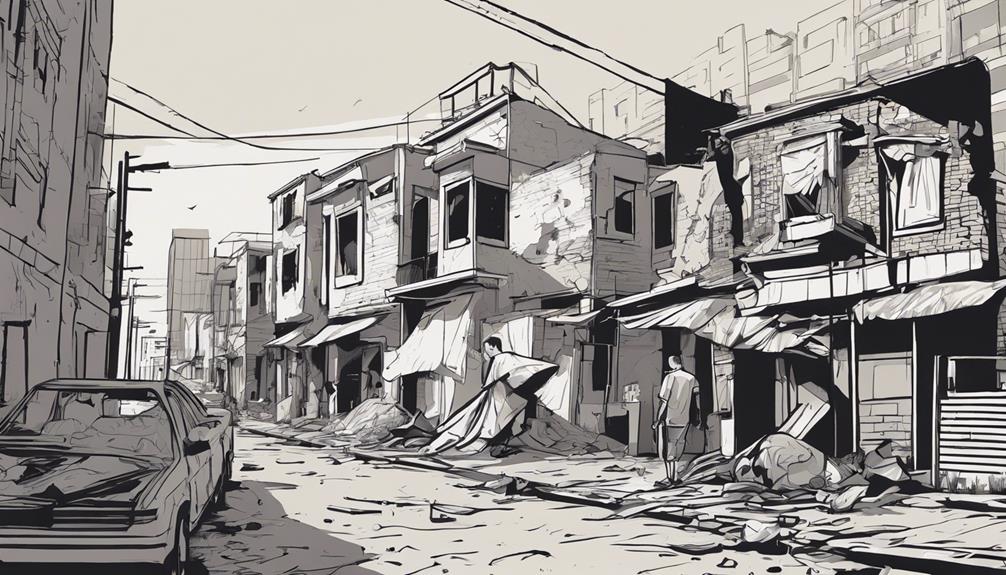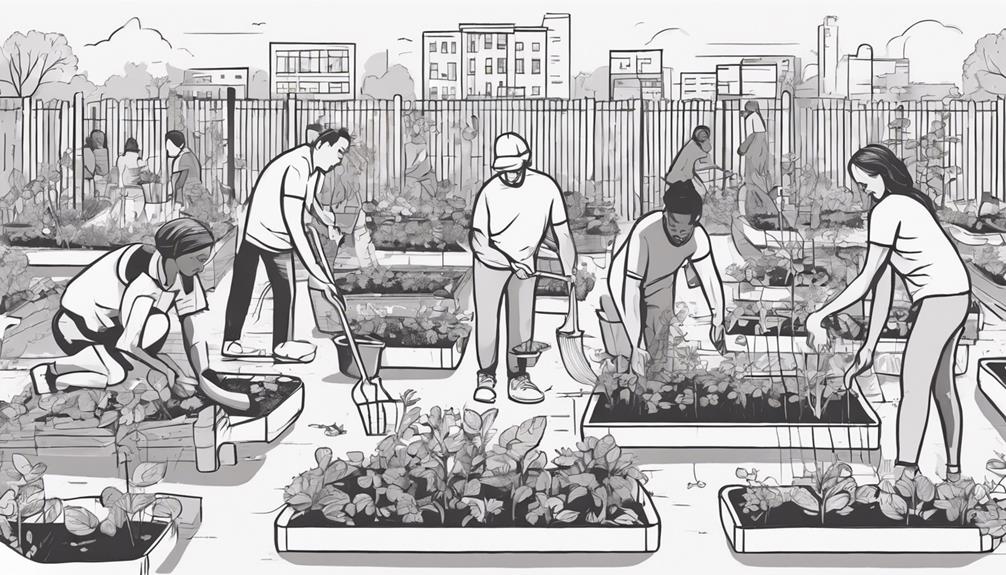Poverty, a pervasive issue affecting millions worldwide, prompts a crucial inquiry into its nature and origins. Defined by a lack of essential resources, poverty's complexities extend beyond monetary constraints to encompass broader societal disparities. Understanding the multifaceted dimensions of poverty, including absolute, relative, and multidimensional aspects, unveils the intricate web of factors contributing to this social dilemma. By exploring the causes and consequences of poverty, we can decipher the mechanisms perpetuating its existence and evaluate strategies aimed at fostering sustainable solutions.
Key Takeaways
- Poverty is a complex socio-economic condition linked to insufficient access to essential resources.
- Causes of poverty include income disparities, lack of education, discrimination, and environmental challenges.
- Poverty impacts children through malnutrition, limited education, healthcare barriers, and exploitation risks.
- Efforts to combat poverty involve programs like child sponsorship, education initiatives, livelihood support, and infrastructure development.
Definition of Poverty

Poverty is a socio-economic condition characterized by a lack of access to essential resources and basic necessities. This deprivation encompasses various facets of human life, including inadequate shelter, limited healthcare services, lack of education opportunities, and insufficient access to clean water. According to the World Bank, the international poverty line is set at $2.15 per day to measure extreme poverty, highlighting the stark reality faced by millions worldwide.
In poverty-stricken areas, individuals often struggle to meet their most fundamental needs. This includes challenges in securing proper shelter, which impacts overall well-being and exposes individuals to harsh living conditions. Furthermore, limited access to healthcare services hinders disease prevention and treatment, leading to increased mortality rates among impoverished populations. Education is also significantly affected by poverty, with children facing barriers to quality learning environments and opportunities for academic advancement. Additionally, the absence of clean water and sanitation facilities in impoverished regions contributes to the spread of preventable illnesses, highlighting the urgent need for targeted interventions to alleviate the burdens of poverty.
Absolute Vs. Relative Poverty
Absolute poverty is often quantified by an income threshold necessary to meet basic needs, while relative poverty compares one's income to the median within a society. Understanding both forms is crucial for comprehending the varying degrees of deprivation and inequality present in communities. Policymakers can utilize this distinction to tailor interventions that address specific challenges and work towards a more equitable society.
Definition of Poverty
In examining the nuances of economic deprivation, distinguishing between absolute and relative measures of poverty is crucial for understanding the multifaceted nature of socio-economic disparities. Absolute poverty is defined by living on less than $2.15 per day, lacking basic necessities like food and shelter. On the other hand, relative poverty is based on income relative to the median income of a country, highlighting disparities within populations. The World Bank sets the international poverty line at $2.15 per day to measure extreme poverty globally. Absolute poverty focuses on the inability to afford essentials, while relative poverty considers income disparities within societies. Understanding these concepts is vital for addressing the varying levels of deprivation experienced by individuals.
| Concept | Absolute Poverty | Relative Poverty |
|---|---|---|
| Definition | Living on less than $2.15 per day | Income relative to median income |
| Focus | Lack of basic necessities like food and shelter | Disparities within populations |
| Global Measurement | Set by the World Bank at $2.15 per day | Varied across different income levels |
Causes of Poverty
Examining the underlying factors contributing to economic disparities provides crucial insights into the origins of deprivation, distinguishing between absolute and relative measures of financial need. When delving into the causes of poverty, it becomes evident that:
- Absolute poverty hinders access to basic necessities like food and shelter.
- Relative poverty showcases income disparities within societies.
- Global poverty rates increase significantly when considering access to services beyond income thresholds.
- Understanding the distinctions between absolute and relative poverty is vital for developing targeted interventions to address different levels of deprivation effectively. By recognizing the nuances between income levels and disparities, societies can tailor solutions to alleviate poverty and promote a more equitable distribution of resources.
Impact on Society
Exploring the societal ramifications of poverty, both in its absolute form, which pertains to the deprivation of basic necessities, and its relative manifestation, which underscores income disparities within communities, is imperative for understanding the multifaceted impact of economic deprivation on social structures and welfare systems. Absolute poverty directly affects individuals' ability to access essential needs for survival, while relative poverty highlights inequalities and social exclusion within societies. These different forms of poverty influence policies, social welfare programs, and societal cohesion. Understanding the distinctions between absolute and relative poverty can lead to more targeted interventions and policies aimed at alleviating the diverse impacts of economic deprivation on society.
| Aspect | Absolute Poverty | Relative Poverty |
|---|---|---|
| Definition | Inability to afford basic necessities like food and shelter | Based on income comparisons within a society |
| Impact on Society | Directly affects individuals' survival and well-being | Emphasizes disparities and social exclusion |
| Policy Implications | Calls for immediate assistance and basic needs provision | Highlights the need for income redistribution measures |
Multidimensional Aspects of Poverty
Considering poverty's multifaceted nature, it is essential to explore its various dimensions beyond just income. Factors like health, education, and living standards play interconnected roles in shaping individuals' experiences of poverty. By understanding and addressing these diverse aspects, a more holistic approach to poverty alleviation can be developed.
Poverty's Different Dimensions
Poverty's different dimensions encompass a spectrum of factors that extend beyond mere income levels, including health, education, and living standards. When considering multidimensional poverty, it is crucial to understand the various aspects of deprivation individuals face. Lack of access to basic services like healthcare and education significantly contributes to this form of poverty. Multidimensional poverty assessments offer a more comprehensive view of individuals' well-being, highlighting the interconnected nature of different factors. Addressing multidimensional poverty necessitates holistic approaches that target all areas of deprivation simultaneously, recognizing that well-being is influenced by a combination of factors. By acknowledging these different dimensions, efforts to alleviate poverty can be more effective and sustainable in the long term.
Causes of Poverty
The complexity of poverty extends far beyond income levels, encompassing a myriad of interconnected factors such as lack of access to education, healthcare, clean water, and sanitation, highlighting the multidimensional aspects that contribute to its pervasive nature. Global poverty is influenced by systemic issues like discrimination, limited opportunities, and inadequate social support systems, creating a cycle of deprivation for many individuals. Marginalized groups face higher rates of poverty due to barriers such as gender inequality, caste systems, and restricted access to resources and opportunities. Additionally, conflict, environmental issues, health challenges, and lack of infrastructure further compound the intricate web of factors contributing to poverty on a global scale. Understanding these diverse causes is crucial in developing effective strategies to address and alleviate poverty worldwide.
Impact on Children
Children in impoverished conditions face a myriad of challenges that significantly impact their overall well-being and future prospects. The effects of poverty on children are profound and multifaceted:
- Malnutrition: Children living in poverty often lack access to an adequate and nutritious diet, leading to malnutrition, stunted growth, and developmental delays.
- Education: Poverty limits children's access to quality education, hindering their cognitive development and perpetuating the cycle of poverty across generations.
- Healthcare: Impoverished children face barriers to healthcare services, resulting in higher rates of preventable illnesses, reduced life expectancy, and increased mortality rates.
- Child Labor: In impoverished households, children may be forced into child labor or early marriages to contribute to the family income, depriving them of a proper childhood and educational opportunities.
These challenges not only impact the immediate well-being of children but also have long-term consequences on their physical, mental, and emotional health, perpetuating intergenerational cycles of disadvantage and limiting their overall quality of life.
Global Poverty Hotspots
In the landscape of global socioeconomic disparities, certain regions stand out as critical focal points for extreme poverty intervention efforts. Africa, with 430.3 million people living in extreme poverty, is one of the largest global poverty hotspots. Asia, home to 120.3 million individuals in extreme poverty, faces unique challenges in poverty reduction. South America, with 29 million people living in extreme poverty, showcases regional disparities in poverty distribution. The Democratic Republic of Congo, with 68 million individuals in extreme poverty, presents significant challenges for poverty alleviation programs. Severe droughts exacerbate poverty in regions like Somalia, adding hurdles to combating poverty in these global hotspots.
| Region | Population in Extreme Poverty |
|---|---|
| Africa | 430.3 million |
| Asia | 120.3 million |
| South America | 29 million |
| Democratic Republic of Congo | 68 million |
| Severe Drought Impact | Exacerbates poverty |
Causes of Poverty

Amidst the intricate web of socio-economic factors influencing global disparities, the root causes of poverty manifest through a complex interplay of systemic challenges and structural deficiencies. The following list encapsulates the critical factors contributing to the perpetuation of poverty:
- Lack of access to education and skills development: Without proper education and opportunities for skill enhancement, individuals are unable to break the cycle of poverty.
- Inadequate infrastructure and public works: Communities lacking essential infrastructure and public services struggle to create economic opportunities, trapping them in poverty.
- Discrimination and marginalization: Systemic biases and exclusionary practices prevent marginalized groups from accessing resources and opportunities, perpetuating their impoverished conditions.
- Conflict-related factors and environmental challenges: Conflict and environmental issues, such as climate change, disproportionately affect vulnerable populations, leading to displacement and exacerbating poverty.
Understanding these multifaceted causes is essential in devising sustainable solutions to address poverty and uplift affected communities.
Breaking the Poverty Cycle
Addressing the systemic barriers and deficiencies that perpetuate poverty is paramount in breaking the cycle of economic deprivation. Lack of education, healthcare, and economic opportunities are significant root causes that must be tackled to effectively combat poverty. Providing access to quality education and skills training plays a crucial role in empowering individuals to escape poverty by increasing their employability and income-earning potential. Implementing sustainable livelihood programs and job creation initiatives can offer alternative paths for individuals to secure stable incomes, thereby breaking the poverty cycle. Strengthening social support systems and community networks is also vital in providing a safety net for those vulnerable to poverty, ensuring they have the necessary resources and assistance to improve their circumstances. Furthermore, investing in infrastructure development and public works projects can stimulate economic growth, create employment opportunities, and enhance overall living conditions, thus contributing to breaking the poverty cycle effectively.
Efforts to Combat Poverty

Efforts to combat poverty require a multifaceted approach that encompasses strategic interventions and targeted initiatives aimed at enhancing socio-economic conditions and fostering sustainable development. In this endeavor, organizations like World Vision have played a significant role in poverty alleviation through innovative methods such as child sponsorship programs. Here are some key points illustrating the impact of such efforts:
- Child sponsorship programs, like those run by World Vision, have shown tangible progress in addressing poverty in various communities.
- World Vision's long-term Area Development Programs have demonstrated positive outcomes in poverty alleviation by focusing on educational advancements and overall well-being.
- Child sponsorship initiatives not only contribute to educational advancements but also play a crucial role in supporting children in conflict zones, providing them with essential support and protection.
- Communication barriers between sponsored children and their sponsors are effectively bridged through the use of various innovative methods and technologies, ensuring a more connected and supportive relationship for sustainable development.
Societal Impacts of Poverty
The pervasive nature of poverty in society manifests in a multitude of detrimental impacts on various facets of communal well-being. These impacts range from straining public resources due to increased healthcare costs to hindering educational attainment and perpetuating cycles of disadvantage. Social cohesion is also significantly weakened by poverty, affecting community relationships, trust, and overall societal stability. Furthermore, poverty amplifies mental health issues, leading to social exclusion, marginalization, and a higher prevalence of crime rates within impoverished areas.
| Societal Impact | Description |
|---|---|
| Healthcare Costs | Poverty contributes to increased healthcare costs, as individuals may delay seeking medical treatment. |
| Educational Attainment | Poverty hinders educational opportunities, perpetuating cycles of disadvantage. |
| Social Cohesion | Poverty weakens social cohesion, impacting community relationships and trust. |
| Mental Health | Poverty amplifies mental health issues, leading to social exclusion and marginalization. |
| Crime Rates | Poverty is associated with higher crime rates, challenging societal stability. |
Frequently Asked Questions
What Exactly Causes Poverty?
Poverty is primarily caused by economic disparities, lack of education, high unemployment rates, health issues, discrimination against minorities, inadequate government policies, globalization effects, unaffordable housing, income inequality, and insufficient social welfare programs. These factors create barriers to economic stability, perpetuating cycles of poverty. Addressing these root causes through targeted interventions and policy changes is crucial in combating poverty and promoting sustainable development.
What Is Poverty in Simple Words?
Poverty, in simple terms, is the state of economic struggle where individuals lack the financial security to access basic needs like food, shelter, and healthcare. It stems from limited resources, social inequalities, and insufficient opportunities leading to high unemployment rates. The poverty cycle is perpetuated by income disparity and uneven wealth distribution, creating a significant barrier for individuals to achieve a decent standard of living.
What Is Causing Poverty in America?
In America, poverty is fueled by economic inequality, lack of education, job loss, financial crises, systemic racism, high cost of living, limited access to resources, health issues, a homelessness epidemic, and generational poverty. These factors intertwine to create a complex web of challenges that perpetuate the cycle of poverty. Addressing these root causes through targeted policies, social programs, and systemic reforms is essential to combatting poverty in America and creating a more equitable society.
Who Does Poverty Happen To?
Poverty affects a wide range of individuals, including children, marginalized groups, and populations in conflict zones. Economic factors, social inequality, high unemployment rates, lack of education, health disparities, geographic location, discrimination, family dynamics, limited resources, and government policies all play significant roles in the occurrence of poverty. Understanding these complex interactions is crucial in addressing the multi-faceted nature of poverty and developing effective interventions to alleviate it.
Conclusion
In conclusion, poverty is a complex societal issue that manifests in various forms and impacts individuals across the globe. The multidimensional nature of poverty highlights the need for comprehensive approaches to address its root causes and consequences. By understanding the different types of poverty and implementing effective strategies to combat it, societies can work towards breaking the cycle of deprivation and promoting social equity. It is imperative that concerted efforts are made to alleviate poverty and create a more equitable world for all.
